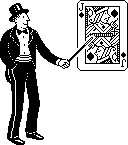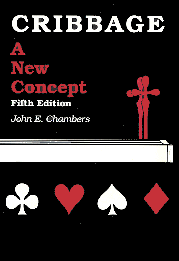How to analyze discards, part 1
![]()
 |
|
Knowing how to analyze discarding decisions is
an essential skill for expert players. Although many areas of the game are
governed by the intangibles of "judgment", discarding is one area where you
can apply some mathematical rigor. This article describes how to do that,
and introduces some statistical terminology in the process.
Calculating discards is straightforward, but it requires a lot of arithmetic. To do it during the course of a game you'd have to be either a math prodigy or a computer. The techniques I'll offer here are best used during your study time: to analyze what-if scenarios, evaluate what you read in cribbage books, and find improvements in your own play. The next time you face a tough discarding decision in a game, especially one you feel unsure about, write down the hand and the board position, and analyze your decision afterwards. If your analysis uncovers a better way to manage the hand, or even if it confirms the toss you did make, add a note to your personal cribbage database. It's remarkable how often certain hands can repeat themselves. And it's a great feeling to be able to handle a situation with confidence because you know the right play, having determined it through analysis, not guesswork. Average handWith the score tied 46*-46, you deal yourself the following:
This is a nice looking hand, but there are several ways to handle it. The obvious move is to keep the double run (3-4-5-5). This can fetch you as many as 20 points (on a 3 cut), and gets at least 12 points on anything but an A, 8 or 9. Tossing those double 5s to your crib is also tempting. You'll score big if pone tosses you a couple of ten-cards, and the 2-3-4-J that you keep will improve on any cut but a 7. Another possibility is to keep the flush, worth eight points off the bat, with the promising 4-5 going into your crib. Which discard gets the most points over the long run, and how do you calculate this? First let's consider holding 3 Thus, for aces, multiply 4 (the number of aces that can be cut) by 10 (the value of 3-4-5-5 with an A starter), getting 40. Likewise, for 5s, multiply 2 (the number of 5s that can be cut, since you've got the other two) by 17 (the value of 3-4-5-5 with a 5 starter), getting 34. Add the thirteen products together, then divide the total by 46. This is
the average hand: what your hand will be worth, on average, after the
cut. In this case it's
Considering that a typical cribbage hand is worth about eight points after the cut, the fact that this hand scores 4½ points more than that amply demonstrates its scoring potential. It gets 16 points or more on eight different cuts, and fails to improve only on a 9 cut. Expected averageThe next step is to factor in the expected value of the crib based on
your 2
Add the average crib to the average hand to get the expected average: the average combined value of your hand and crib after the cut.
The expected average is the single most important number to consider in discarding. It is a very accurate indicator of the combined scoring potential of hand and crib. In most circumstances where offense is the paramount consideration, the best discard is the one that produces the highest expected average. Obviously, the accuracy of this calculation depends on the quality of the average crib figure it is based on. And these figures can vary from source to source. My own discard tables attempt to compensate for differences between the primary sources, and for statistical margins of error and other distortions that occasionally creep in. But you might want to use more than one source for your calculations, drawing a separate expected average from each one. Usually the final numbers will match closely, as is the case here. You'll notice that by discarding two clubs to the
crib, you've created the possibility of a crib flush. The chance of getting
one of these is so slight (about 1 in 150), that I usually don't bother
including it in my calculations. But if you want to be thorough, you can add
.03 points
Now that we know what to expect from 3
Note that this hand gets a maximum of 12 points (on a 2 or
3 cut), and a minimum of five points (on a 7
cut). Now we'll factor in the average value of the 5
These numbers indicate that although 2-3-4-J returns far less in the hand than 3-4-5-5, the crib potential of the 5-5 toss more than compensates. In the long run, you'll get ½ to ¾ points more between your hand and crib by tossing the 5s. Finally, let's see how keeping 2
Once again, throw in the average value of the crib, based on discarding
4
Interestingly, although the flush play gets neither the best average crib
(it's second to tossing 5-5), nor the best average hand (it's
second to keeping the double run), it still gets the best expected average
of the bunch, returning a point more than keeping 2-3-4-J,
and 1½ points more than keeping 3-4-5-5. The flush hand
itself will fetch at least eight points, and can get as many as 14 (on a
4 Chambers average |
||||||||||||||||||||||||||||||||||||||||||||||||||||||||||||||||||||||||||||||||||||||||||||||||||||||||||||||||||||||||||||||||||||||||||||||||||||||||||||||||||||||||||||||||||||||||||||||||||||||||||||||||||||||||||||||||||||||||||||||||||||||||||||||||||||||||||||||||||||||||||||||||||||||||||||||||||||||||||||||||||||||||||||||||||||||||||||||||||||||||||||||||||||||||||||||||||||||||||||||||||||||||||||||||||||||||||||||||||||||||||||||||||||||||||||||||||||||||||||||||||||||||||||||||||||||||||||||||||||||||||||||||
 |
An alternative approach is described by John Chambers in
Chapter 12 of his book
Cribbage: A New Concept. Chambers obtains the average hand using the
same method described above. But instead of adding the average crib to this
value to obtain an expected average, Chambers computes the minimal
value of the crib based only on the two cards you toss. This is done by
calculating the value of those two cards combined with all the possible
starters. Your opponent's toss is disregarded.
Let's apply this to the option of keeping 3
Add the two averages together to obtain the minimal average: the minimum average combined value of your hand and crib after the cut. I'll refer to this as the Chambers average henceforth.
Again, I have ignored the possible crib flush in my calculations. But if you like, add .04 points when tossing two cards of the same suit. In his book, Chambers neglects to provide for His Nobs and five-card flushes in the hand, but I include these contingencies in my calculations, and I recommend you do the same. Although it is objectively less accurate than the expected average, the Chambers average is still a useful number to have, since it only reflects factors your opponent cannot control. With it, you can gauge the relative risk level of different tosses. Consider how the averages compare for our three discarding alternatives:
You'll notice that the toss with the lowest expected average (2-J) nevertheless gets the highest Chambers average. The 5-5 and 4-5 tosses will return more points on average over the long run, but their lower Chambers average indicates that they rely on a productive crib for more of their value, and are therefore subject to more risk. Your opponent may decide to sacrifice points to deliberately balk your crib. Or you could just get unlucky — if you toss yourself 5-5 only to have pone throw you 2-4 and cut a 7, you'll probably be pretty disappointed with your two point crib. Although I principally rely on expected averages to evaluate a hand, I always calculate the Chambers average as well. If two alternatives with roughly the same expected average and pegging potential present themselves, I'll usually favor the one with the best Chambers average. One example from my personal database is A-2-4-6-7-x, where tossing A-4 gets roughly the same expected average as tossing 6-7, but a significantly lower Chambers average (by .83 points). With the expected averages so close, I'd keep the safer A-2-4-x, which keeps more of the scoring potential away from your opponent's influence. Other considerationsAs valuable as these calculations are, they must be balanced against other less quantifiable considerations that often come into play when making discarding decisions. An obvious one is pegging potential, whose exploitation is frequently worth a sacrifice in hand or crib value. From A-A-8-9-J-K, DeLynn Colvert advises keeping A-A-8-9 instead of A-A-J-K. The latter gets a ¾ point higher expected average, but Colvert feels this is outweighed by the unusually good pegging potential of A-A-8-9, which gets an easy 31-4 if pone has ten-cards (Play Winning Cribbage, p. 42). Other times you may need to peg defensively. Holding 4-4-5-6-10-J you would ordinarily keep 4-4-5-6. But if the score is 111*-111, then 4-5-6-10 is the right choice, giving you a much better chance to avoid pegging situations that would only benefit your opponent. Clearly, board position can elevate the significance of pegging potential in your assessment of a hand. But it can also dictate a shift in statistical priorities. Although your goal in discarding is normally to optimize your average score, at times you may wish to go for maximum count instead. Holding 4-4-6-6-7-K, you'll get the best expected average keeping 4-4-7-K and tossing 6-6. But if you're so far behind in the game that only a barnburner hand will give you a chance to win, then by all means keep 4-4-6-6. This costs you about ¾ points off the expected average, but it retains your only chance for a 24 point hand, a one in 11½ shot. Likewise, if you deal yourself A-3-7-8-J-Q needing a miracle to win, try keeping A-3-J-Q. You'd have a better pegging hand holding A-3-7-8, but by tossing 7-8 you have a shot at as many as 24 points in the crib if pone obliges you with a couple mid-cards. A long shot to be sure, but perhaps the best shot if only a score of that magnitude will make a difference. Psychology and knowledge of your opponent's habits can also play a role in discarding. If you're playing someone who's prone to making risky discards to keep his own scoring chances intact, then toss those 5s and 7-8 combinations to your crib! Conversely, if he's a conservative player who'd rather break up a double run than throw you cards you might actually use, then think twice before tossing your best scoring cards into the crib. Perhaps your opponent is the sort who carelessly exposes his discards on their way to the crib. If that's the case, you probably don't need to worry too much about the averages... The addition method revisitedIn the article Discarding to your crib, I described an addition method that you can use to help with discarding decisions in real games. Let's see how this method, and the simpler shorthand method would be applied to this hand:
As you can see, either method guides you to the optimal toss. Of course this won't be the case for every hand. But the more you study and analyze on your own, the more you'll refine your feel for the tricky art of discarding, and the less you'll need to rely on mental shortcuts. ExercisesHere's a chance to put your new knowledge to use.
We'll go over the answers in part 2, then discuss how to analyze discards as pone. - April 2000 (updated February 2002) |
|||||||||||||||||||||||||||||||||||||||||||||||||||||||||||||||||||||||||||||||||||||||||||||||||||||||||||||||||||||||||||||||||||||||||||||||||||||||||||||||||||||||||||||||||||||||||||||||||||||||||||||||||||||||||||||||||||||||||||||||||||||||||||||||||||||||||||||||||||||||||||||||||||||||||||||||||||||||||||||||||||||||||||||||||||||||||||||||||||||||||||||||||||||||||||||||||||||||||||||||||||||||||||||||||||||||||||||||||||||||||||||||||||||||||||||||||||||||||||||||||||||||||||||||||||||||||||||||||||||||||||||||||
![]()
![]() prior
article | Cribbage Forum home |
next article
prior
article | Cribbage Forum home |
next article![]()
Schellsburg home
![]()
Cribbage Forum features articles on cribbage strategy and tactics
by Michael Schell.
Original Material and HTML Coding Copyright © 2000-2 by Michael Schell. All
Rights Reserved.